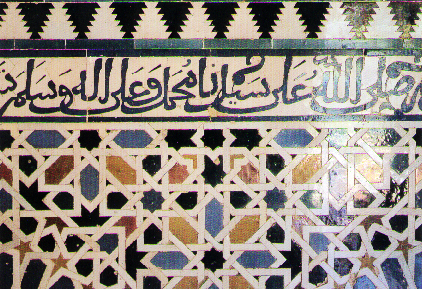With a religious proscription against painting 'graven images,' the
artists of the Islamic world excelled in the use of pattern and the calligraphic
word. This section of a wall from the Nazarid Palace inside the Alhambra
in Granada, Spain is an excellent example. Tiles are meticulously cut and
pieced into an intricate mosaic of pattern and text. Note that the tiles
are lustered. Glazed tiles are called azulejos in Spanish. The grand palaces
of the rulers of Granada, Córdoba, and other Andalusian cities exhibit
the apex of the Spanish lusterware and architectural tile tradition. Even
the inscription is composed of intricately cut azulejo mosaic, rather than
simply being painted on. It reads: 'In the name of Allah, the merciful,
the compassionate,' the phrase spoken by all devout Muslims before the start
of any action. Repeating throughout the mosiac design is the 'Islamic Star'
shape. The star is a conspicuous symbol in Islamic iconography, a regular
geometric shape that symbolizes equal radiation in all directions from a
central point. The star is an apt symbol of a religion that emphasizes one
God, and symbol of the role of Mecca, the center of Islam, toward which
all Moslems face in prayer. The rays of a star reach out in all directions,
making the star a fitting symbol for the spread of Islam. Complex geometric
designs create the impression of unending repetition, which is believed
by some to represent the infinite (unending in time and space) nature of
God. In religious buildings and palaces, as well as in common objects like
bowls and rugs, the art of Arabic geometric designs is very common. The
star was the most common Islamic design.
'Paramentos' are tile mosaic coverings that are found on the walls of the interior rooms of buildings such as the Hall of the Ambassadors and the Hall of the Captives in the Nazarid Palace in the Alhambra. This one is made with alternating white and colored lustered azulejos. Such paramentos reach from the floor to about shoulder height and can be seen in the last image of the interior of the Hall of the Ambassadors. Above these tile paramentos are elaborate stucco moldings that reach all the way to the ceiling.

Paramento with glazed tile with Kufic script from the Hall of the Captives,
Nazarid Palace, Alhambra, Granada, Spain 1350 CE


